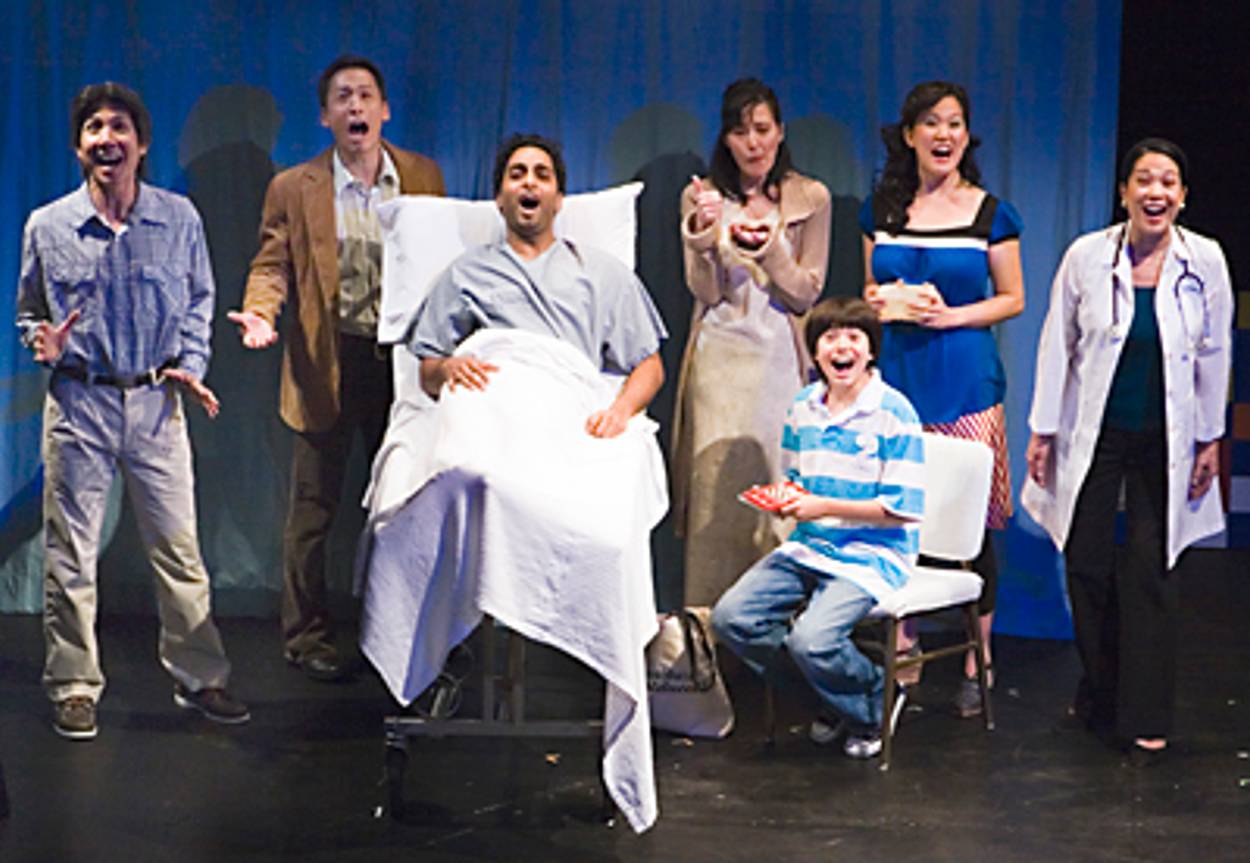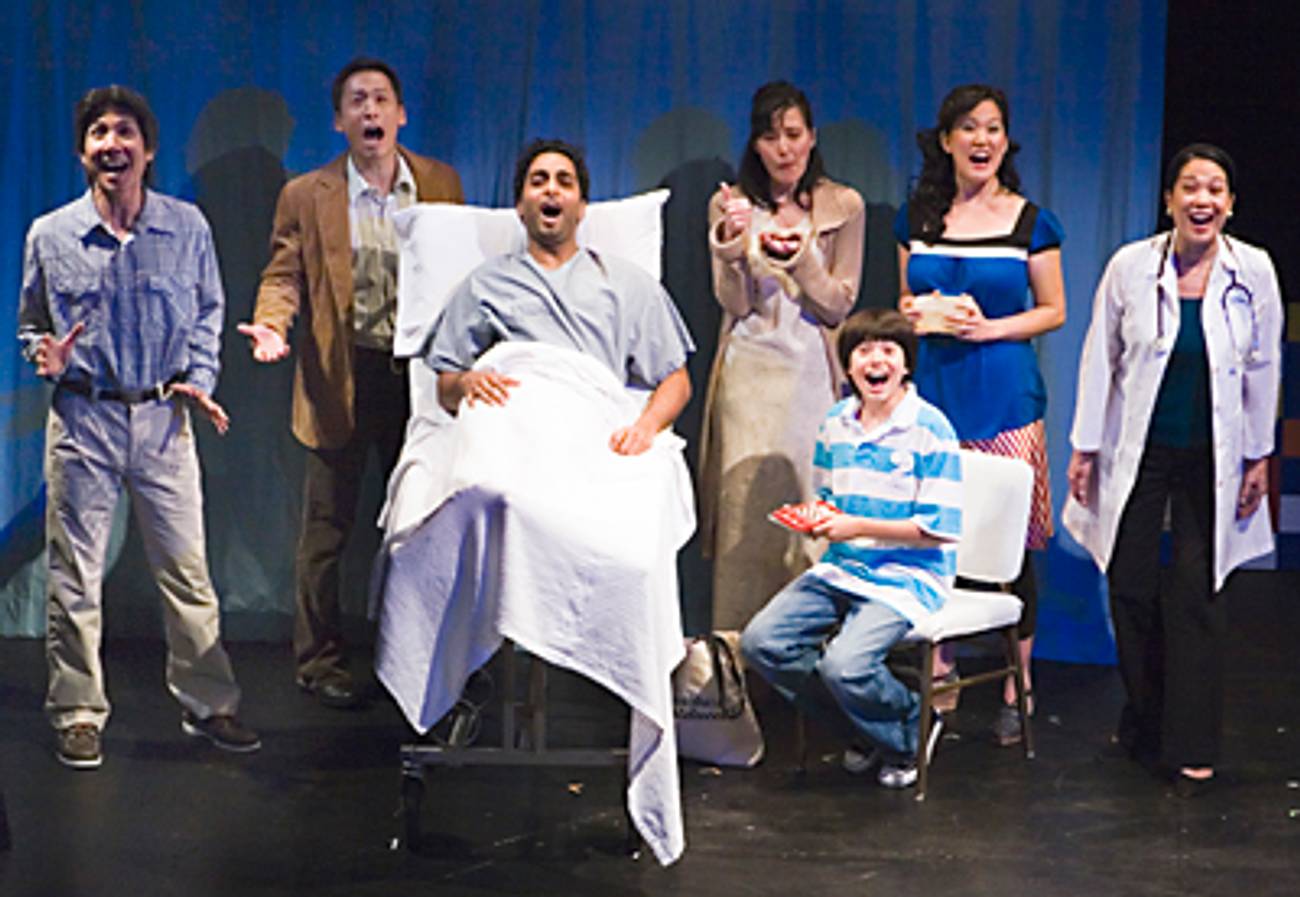East Meets Kvetch
An all-Asian troupe performs a musical about kosher caterers, short insomniacs, and hypochondriacs




Back in 1990, when William Finn and James Lapine premiered Falsettoland, their Sondheim-esque musical about the mores of 1980s New York Jewry, they probably never imagined that the show’s “kosher caterers, short insomniacs, hypochondriacs, Yiddish Americans, crazy families, radiologists, intellectuals, [and] nervous wrecks” would someday be played by actors named Hu, Jue, Ma, and Wu. But that’s what audiences are getting this month at the Dimson Theatre, where the National Asian American Theatre Company (NAATCO) is remounting its 1998 production of Falsettoland, directed by Alan Muraoka and cast entirely with actors of Asian descent.
Presented as part of the first annual National Asian American Theatre Festival, Falsettoland features songs with titles like “The Miracle of Judaism”; charming—if shopworn—jokes about gefilte fish and the athletic ineptitude of Jewish boys (“Remember Sandy Koufax!” the stepfather calls out hopefully on game day); as well as references to Rubik’s Cubes, yuppie angst, and that newfangled activity known as “working out.” With its spare set and single piano, the incongruously ethnic production brought me back to my days as a high school thespian, in a town whose high immigrant population meant that I, an Asian girl, could somehow wind up playing both a lovelorn Haitian chambermaid and Oliver Twist in the same season.
But opportunities for Asian actors remain slim in professional theater—especially when it comes to getting lots of them onstage all at once. (Quick, can you name five shows that call for large Asian casts besides Miss Saigon, The King and I, and Flower Drum Song?) This is where NAATCO comes in. The 18-year-old theater company produces American and European classics with entirely Asian-American casts, and they do so without changing the dialogue or settings. Last week, for example, NAATCO ended its run of Federico García Lorca’s House of Bernarda Alba, a torrid family drama set in rural Spain. By refusing to alter the material to justify its casting—say, setting Shakespeare among the samurai, as Akira Kurosawa did with his films Ran and Throne of Blood—NAATCO upholds a beautifully expansive view of the theater, where any play that’s good can be considered an Asian play.
Originally performed in 1990, Falsettoland is the third in a trio of one-acts about Marvin, a self-obsessed thirtysomething who leaves his wife and son to live with his male lover, Whizzer.
In the earlier installments of the trilogy, Marvin’s attempts to “have it all” backfire: his ex-wife, Trina, ends up marrying his former shrink, and Whizzer leaves him. In Falsettoland, Marvin’s relations with Trina remain strained, especially as they try to plan their son Jason’s bar mitzvah while shuttling the boy between them. The show takes a sharp turn about halfway through when Whizzer, reunited with Marvin, falls prey to the unnamed illness that is felling “sick and frightened bachelors” all over the city.
Falsettoland and its predecessors, 1979’s In Trousers and 1981’s March of the Falsettos, were not only lovely, funny pieces of work but were also crucial salvos in the culture wars of the period. The latter two, performed together on Broadway in 1992 as Falsettos (with its logo by Keith Haring), represented an early, striking portrait of family life in the AIDS era. In a 1992 essay, the novelist Michael Cunningham writes of his thankfulness for the fully human gay characters in Finn’s play—acerbic, competitive, neither saintly nor shallowly sex-obsessed.
But while Falsettoland remains an important piece of political art (not to mention a gorgeously tuneful weeper), in NAATCO’s production, the material begins to show its age. Maybe it’s because we’re currently awash in 80s nostalgia (leggings, anyone?), or perhaps it’s because gay characters dying from a mysterious new disease has—thankfully—become a distinctly old-fashioned literary trope, like the bloody cough into the handkerchief that cued the violins in Victorian melodramas.
Another reason the current production feels dated is that the performances are—well, toothless. The relationships, romantic and otherwise, are not always convincing and the characters often feel flat—and, it has to be said, not Jewish enough. In his New York Times review of the 1998 production, Peter Marks notes that it is the “ritualized neuroses of Jewish New Yorkers in the 1980s that Mr. Muraoka’s cast has the most difficulty reinterpreting,” and the same holds true for the 2007 production, which features many of the same actors.
Not only do the characters in this Falsettoland lack the acid-tinged self-regard Cunningham so admired—everyone here seems so sweetly mild-mannered, you wonder why they’re fighting in the first place—but they never quite rise to the manic heights suggested by Finn’s caustic, rapid-fire songcraft. Some of the actors’ reticence may stem from the cast’s understandable discomfort with Finn’s schticky, sometimes stereotypical characters—who wants to be accused of being a minstrel? They pitch their anxieties at a much lower level, going for pleasant grumpiness instead of full-throttle freneticism.
For all the talk about how Asians are the new Jews (Our immigrant mothers are pushy! We like books and sit first chair in the school band!), Falsettoland made me wonder about the legitimacy of NAATCO’s cross-casting policy. It’s not that I don’t think Asians could do a truly great production of Falsettoland—or Fiddler on the Roof or Merchant of Venice, for that matter. But to do any play justice, the actors must make a full, flesh-and-blood commitment to its characters. Take House of Bernarda Alba: NAATCO’s all-female cast tore into their roles, crafting each character with such care and attention that after a few minutes you hardly noticed the actresses’ ethnicity. Granted, Bernarda Alba is a lot less culturally specific than Falsettoland; given the average New Yorker’s limited understanding of early 20th-century Andalusia, the play essentially takes place “long ago and far away,” giving it a mythic quality that’s easily unmoored from its original time and location. Falsettoland is insistently of its time and location, and its characters aren’t mythic: they’re Jewish. By treating its characters so delicately, Muraoka and his cast miss an opportunity to elevate Falsettoland to true “American classic” status, with something honest to offer Jews, Asians, and everyone else.